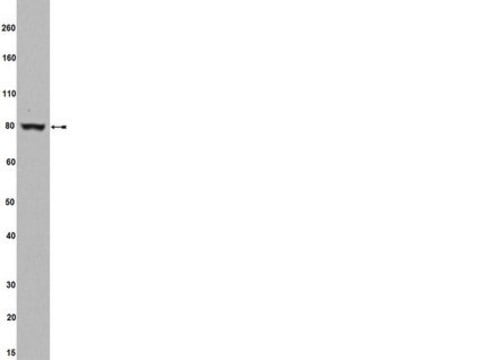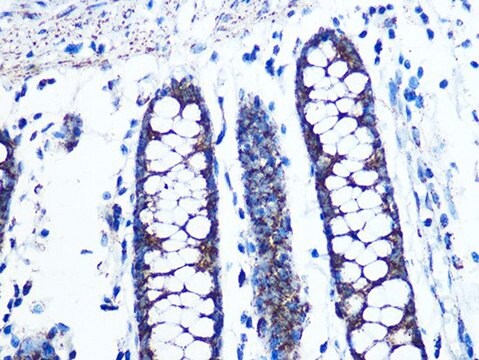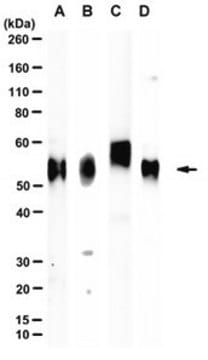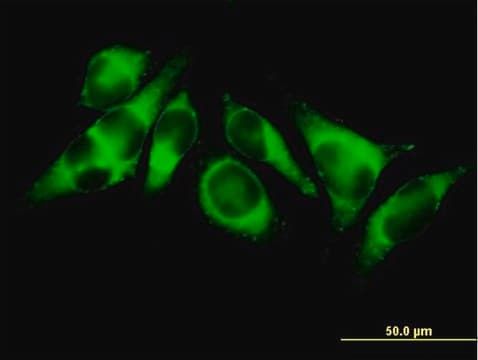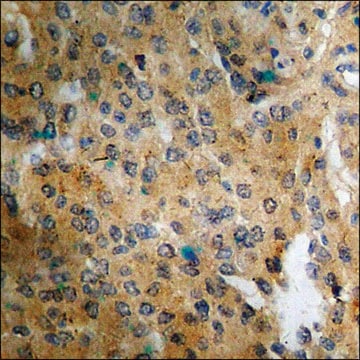일반 설명
We are committed to bringing you greener alternative products, which adhere to one or more of The 12 Principles of Green Chemistry.This antibody is Preservative-free, produced without the harm or sacrifice of animals and exceptionally stable to allow for ambient shipping and storage if needed and thus aligns with "Waste Prevention", "Designing Safer Chemicals" and "Design for Energy Efficiency".
Click here for more information.
ZooMAb® antibodies represent an entirely new generation of recombinant monoclonal antibodies.Each ZooMAb® antibody is manufactured using our proprietary recombinant expression system, purified to homogeneity, and precisely dispensed to produce robust and highly reproducible lot-to-lot consistency. Only top-performing clones are released for use by researchers. Each antibody is validated for high specificity and affinity across multiple applications, including its most commonly used application. ZooMAb® antibodies are reliably available and ready to ship when you need them.
특이성
Clone 1I18 is a ZooMAb® Rabbit recombinant monoclonal antibody that specifically detects Fatty acid CoA ligase Acsl3 (ACSL3). It targets an epitope within 20 amino acids from the C-terminal half.
면역원
KLH-conjugated linear peptide corresponding to 20 amino acids from the C-terminal half of human Fatty acid CoA ligase Acsl3 (ACSL3).
애플리케이션
Quality Control Testing
Evaluated by Western Blotting in HeLa cell lysate.
Western Blotting Analysis (WB): A 1:10,000 dilution of this antibody detected ACSL3 in HeLa cell lysate.
Tested Applications
Western Blotting Analysis: A 1:10,000 dilution from a representative lot detected ACSL3 in A431 cell lysate and 1:1,000 dilution detected ACSL3 in C2C12, and C6 cell lysates.
Affinity Binding Assay: A representative lot of this antibody bound ACSL3 with a KD of 2.7 x 10-7 in an affinity binding assay.
Immunocytochemistry Analysis: A 1:100 dilution from a representative lot detected ACSL3 in HeLa cells.
Immunohistochemistry (Paraffin) Analysis: A 1:100 dilution from a representative lot detected ACSL3 in human placenta tissue sections.
Note: Actual optimal working dilutions must be determined by end user as specimens, and experimental conditions may vary with the end user
표적 설명
Fatty acid CoA ligase Acsl3 (UniProt: O95573; also known as Arachidonate--CoA ligase, EC:6.2.1.15, Long-chain acyl-CoA synthetase 3, LACS 3, Long-chain-fatty-acid--CoA ligase 3, Medium-chain acyl-CoA ligase Acsl3) is encoded by the ACSL3 (also known as ACS3, FACL3, LACS3) gene (Gene ID: 2181) in human. In mammals, Acyl-CoA synthetase (ACSL) enzymes are essential for de novo lipid synthesis, fatty acid catabolism, and remodeling of membranes. These ACSLs are divided into five sub-families based on the chain length of their preferred acyl groups. Activation of fatty acids requires a two-step reaction scheme catalyzed by ACSLs. In the first step, an acyl-AMP intermediate is formed from ATP. AMP is then exchanged with CoA to produce the activated acyl-CoA. ACSL3 is a single-pass type III membrane protein with a transmembrane domain (aa 21-41) and a long cytoplasmic domain )aa 42-720). It is mainly detected in the endoplasmic reticulum and peroxisomes. It is required for the incorporation of fatty acids into phosphatidylcholine, the major phospholipid located on the surface of very low-density lipoproteins (VLDL). It preferentially uses myristate, laurate, arachidonate and eicosapentaenoate as substrates. Overexpression of ACSL3 is shown in human lung cancer and is essential for mutant KRAS lung cancer tumorigenesis. Its suppression is linked to depletion of cellular ATP and death of lung cancer cells. This ZooMAb® recombinant monoclonal antibody, generated by our propriety technology, offers significantly enhanced specificity, affinity, reproducibility, and stability over conventional monoclonals. (Ref.: Padanad, MS., et al. (2016). Cell Reports 16(6); 1614-1628; Soupene, E., and Kuypers, FA. (2008). Exp. Biol. Med. (Maywood). 233(5): 507-521).
물리적 형태
Purified recombinant rabbit monoclonal antibody IgG, lyophilized in PBS, 5% Trehalose, normal appearance a coarse or translucent resin. The PBS/trehalose components in the ZooMAb formulation can have the appearance of a semi-solid (bead like gel) after lyophilization. This is a normal phenomenon. Please follow the recommended reconstitution procedure in the data sheet to dissolve the semi-solid, bead-like, gel-appearing material. The resulting antibody solution is completely stable and functional as proven by full functional testing. Contains no biocide or preservatives, such as azide, or any animal by-products. Larger pack sizes provided as multiples of 25 μL.
재구성
300 μg/mL after reconstitution at 25 μL per vial. Please refer to guidance on suggested starting dilutions and/or titers per application and sample type.
저장 및 안정성
Recommend storage of lyophilized product at 2-8°C; Before reconstitution, micro-centrifuge vials briefly to spin down material to bottom of the vial; Reconstitute each vial by adding 25 μL of filtered lab grade water or PBS; Reconstituted antibodies can be stored at 2-8°C, or -20°C for long term storage. Avoid repeated freeze-thaws.
법적 정보
ZooMAb is a registered trademark of Merck KGaA, Darmstadt, Germany
면책조항
Unless otherwise stated in our catalog or other company documentation accompanying the product(s), our products are intended for research use only and are not to be used for any other purpose, which includes but is not limited to, unauthorized commercial uses, in vitro diagnostic uses, ex vivo or in vivo therapeutic uses or any type of consumption or application to humans or animals.



